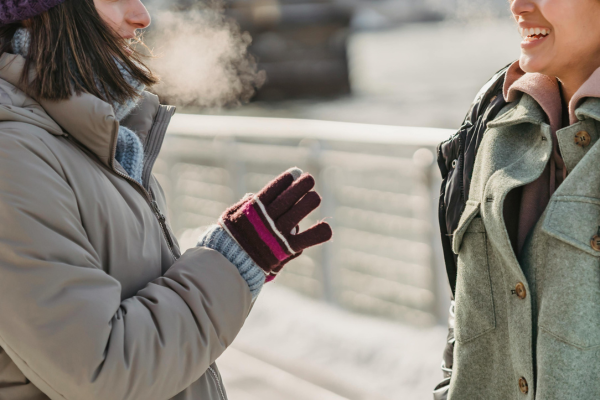
When temperatures drop, most people stop thinking about hydration, but winter dehydration is more common than you might expect. While the symptoms may not be as obvious as they are in the summer, the effects can still impact comfort, concentration, and overall wellbeing.
For organisations, schools, and care environments, this seasonal shift poses a challenge. Staff, students, and guests are less likely to drink water regularly, which can lead to fatigue, reduced productivity, and in some cases, health complications.
In this article, we explore why we get dehydrated in cold weather, what it means for workplaces and institutions, and how taking a proactive stance can make a measurable difference.
Why we get dehydrated in cold weather
When the nights get longer and the days get colder, we may be occupied with thoughts of hearty hot meals rather than cool water, far less aware of dehydration risks.
We’re less thirsty in cold weather, even though our bodies are still losing water through normal processes like breathing, urination, and perspiration.
UNH research suggests thirst levels can drop by as much as 40% in the cold, even though - like heat - the cold steadily decreases our hydration levels. For instance, cold, dry air increases water loss through respiration — every visible puff of breath on a frosty morning is moisture leaving the body. And indoors, heating systems make matters worse.
Central heating and air circulation strip moisture from the air, drying skin and airways while accelerating fluid loss. Add in layers of winter clothing, caffeine-heavy drinks, and a tendency to replace water with tea or coffee, and it’s easy to see how hydration quietly slips down the priority list.
Unlike in summer, the signs of winter dehydration are subtle, not always clearly related to thirst: headaches, tiredness, dry lips, and a drop in focus or alertness.
Learn what dehydration does to the body.
The hidden impact of winter dehydration in organisations
Because people feel less thirsty in cold weather, they often postpone drinking until they are already mildly dehydrated or worse, especially in busy work settings where there may not be much time to stop and think about having a drink. And with indoor heating systems reducing humidity and stripping moisture from the air, organisations may unintentionally be making matters worse.
But a lack of heating can also be an issue. For instance, in wide, open work environments where temperature is less controllable, like warehouses or factories, the cold can discourage hydration throughout the day.
Browse our water dispensers for factories and warehouses.
Even mild dehydration can affect performance, and in winter, it often goes unnoticed. In offices, schools, and other institutional settings, staff and students may experience reduced concentration, slower reaction times, fatigue, and irritability — all of which affect productivity and morale.
Browse our water dispensers suitable for:
For healthcare and care environments, dehydration can be even more serious. Patients and residents may be less able to communicate thirst, and minor fluid loss can make pre-existing conditions worse.
Browse our water dispensers suitable for healthcare facilities.
Recognising these hidden risks is the first step. By understanding how winter dehydration affects people in different institutional contexts, organisations can take proactive steps to maintain hydration, improve wellbeing, and maintain productivity throughout the colder months.
Don’t wait for warmer weather to invest in hydration
Winter doesn’t mean dehydration takes a break. If you’ve been planning to upgrade or install water dispensers when the weather gets warmer, “when they’re needed,” it’s best not to wait.
Providing easy access to filtered, great-tasting water year-round keeps staff, students, and visitors hydrated, alert, and healthy.
Contact Cactus Water Systems today, tell us a bit about your needs, and we can recommend the perfect water solutions for your organisation, handling everything from installation to ongoing maintenance. Explore our services.
How organisations can encourage healthy hydration during the colder months
Once organisations understand the risks of winter dehydration, the next step is creating an environment that encourages regular fluid intake, even when people don’t feel thirsty.
Here are practical strategies that workplaces, schools, and care facilities can implement:
-
Make water easily accessible: Place dispensers in high-traffic areas like reception zones, staff rooms, hallways, and communal spaces. Convenience is key; the more visible and reachable the water, the more likely it will be consumed.
-
Offer temperature options: While chilled water may be preferred in summer, offering ambient or slightly warm water can encourage drinking during colder months.
-
Promote mindful hydration: Use signage, email reminders, or internal campaigns to gently remind staff, students, or residents to drink water regularly.
-
Integrate into routines: Encourage hydration breaks during meetings, classes, or gym sessions. Pairing water with daily activities helps establish habits that persist year-round.
-
Leverage technology: Smart dispensers, water trackers, or hydration apps can provide data and encourage engagement, especially in larger institutions.
For more information about how schools can encourage healthy hydration, see our guide.
Stay hydrated year-round with a Cactus Water System
Talk to CWS about preparing your organisation for winter hydration. We stock a wide range of models spanning bottle filling stations, coolers, boilers, taps, and fountains, so whatever your requirements, we can provide the right solution to keep your people refreshed and healthy year-round. Contact us today.












